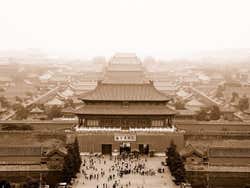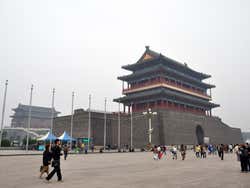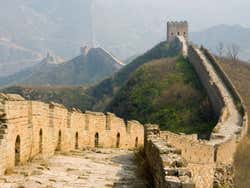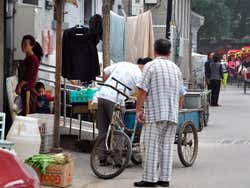
History of Beijing
Find out about the history of Beijing which dates back 3 millenniums, making the Chinese capital one of the oldest cities in the world.
Origins
Prehistoric remains reveal that the area has been inhabited since the Neolithic period. A famous ancestor of ours appeared in this area, a Homo Erectus who was called "Peking Man", one of the oldest links in human evolution found to date.
Beijing was born with the name of Ji or Ki, around the 8th century B.C., suffering revolts between the Fighting Kingdoms during the 5th and 3rd centuries B.C.
The turbulent Qinshi Huangdi came to power, establishing the Qin dynasty and going down in history as the first ruler to unify China. Qinshi ordered the burning of books and regulated the characters of Chinese writing.
In the year 206 B.C. the Qin dynasty succumbed to an army of rebels commanded by Liu Bang, and the Han dynasty was born.
Han and Tang dynasties
It can be said that the Han dynasty (206 BC-220 AD) carved the Chinese soul. The Chinese call themselves Han people, and they call their language the Han language. In the West, we use the term China, which is derived from the Qin dynasty.
During the next four centuries, Beijing experienced a vast amount of change, from the dismemberment of the empire into three kingdoms, the occupation of the Barbarians of the Steppe and the triumph of the Sui dynasty then later the Tang dynasty.
The Tang Dynasty (618-907), founded by Emperor Liang, marked the period of greatest vigour in Chinese culture and arts.
After the fall of the Tang, another turbulent period began. A northern tribe, the Khitan, made Beijing their capital in 938, becoming one of the most important cities in Asia.
The Khitan founded the Liao dynasty and called Beijing Yanjing. Their power spread throughout Asia and the vast empire was known as Katay.
Towards the 12th century, the Jurchen defeated the Khitan and established the Jin dynasty with Beijing as its capital, which they now called Zhongdu.
The Mongolians
In 1215 Beijing was destroyed by the Genghis Khan Empire. A few years later, Kubilai Kan conquered all of China and ordered the reconstruction of Beijing to make it the capital of the Yuan dynasty.
Beijing became known as Dadu, "Great Capital" in Mongolian, the Chinese called it Khanbaliq. It was at this time that Marco Polo visited the city which he called Cambalu.
In 1368, the Chinese commanded by Zhu Yuanzhang expelled Toghan Temür, the last Mongolian sovereign in China, restoring the power of the Han ethnic group and founding the Ming dynasty.
The Ming dynasty
The Ming dynasty would last until 1644. The Ming moved the capital to Nanking, and Beijing was named Beiping or "Peace of the North".
In the early 15th century, Emperor Yongle, the most powerful ruler of the Ming dynasty, decided to move the capital from Nanking to Beiping, which he named Beijing. To accommodate his court, he ordered the Forbidden City to be built.
The Ming dynasty, the last true Chinese dynasty to rule the country, was defeated by the Manchus who established the Qing dynasty (1644-1911).
In 1644 the Manchus set fire to Beijing. They took advantage of its reconstruction to carry out great reforms and Beijing was embellished with works such as the Gate of Heavenly Peace, the Palace of Supreme Harmony and the Summer Palace.
The first emperor of the Qing dynasty was Kangxi whose reign marked a period of splendour. He ordered the Chinese to wear a ponytail, as an outward symbol of submission and forbade mixed marriages between Chinese and Manchu.
The arrival of the West
In the early 19th century, the Western powers set their sights on China. The English, in order to pay for their trade deficit, introduced opium into China.
Opium would be the cause of two wars. During the First Opium War (1839-1842), the Chinese government had to cede Hong Kong Island to Britain and declare Shanghai a free trade port.
In 1860, during the Second Opium War, British and French troops raided Beijing, destroyed the Summer Palace and erected the diplomatic quarter.
Popular discontent against foreigners and the Manchu dynasty led to the birth of many secret societies, one of which was that of the "Worshippers of God". As a sign of rebellion against the Manchu, they ordered members to cut off their pigtails.
In 1900 the Diplomatic Quarter was attacked by the Boxers. The revolts wouldn't stop until the fall of the Qing dynasty in 1911.
From the republic to the present
In 1912 the Manchu empire falls, the Republic is established and the warlords move the capital to Nankin.
In 1920, the Chinese Communist Party was born in Shanghai and would play a fundamental role in the future of China.
In 1928 Chiang Kai-shek's troops took Beijing and he was proclaimed President of China.
In 1937 and until 1945, the end of the Second World War, Beijing is occupied by the Japanese.
In 1949 the communists take power and Beijing is again the capital of China.
Today, Beijing is a huge city of contrasts, where the most modern skyscrapers coexist with the humble Hutongs of the old city and the rehabilitated imperial monuments. A surprising and lively city that captivates tourists.



